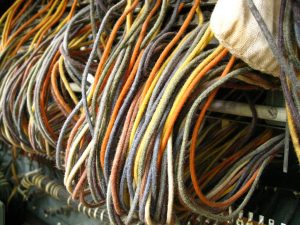
As has come before; many of these posts will be philosophical in nature. Some will be in contradiction to previous postings. These are not intended as truths or assertions, they’re merely thoughts…ideas. Think of this as stream of consciousness over a wide span…Please bare with us as we traverse the abstract canals of audio musings.
Additional Self-Conscious-Writer-Disclosure: As I was writing this piece I became aware there’s a lot of quote-unquote / inverted comma usage in it. Some might say there’s “too much”. If you start to feel that way, just imagine me right by you saying “yeah… but if it works”, and power on though. Thanks.
“I mean… if it works” and “hey… if it sounds/feels good” are phrases I find myself using fairly frequently these days. Often they’re deployed in response to someone who’s concerned their approach to a specific technique isn’t “industry standard”, perhaps a workaround due to technical limitations or a lack of knowledge about how things are typically handled, but “hey, if it sounds good…”. It also comes up when I or someone else designs something technical, yet that’s simple when we feel it should be less so. Maybe we feel the design, or thought-process it represents, wouldn’t impress colleagues due to its sheer simplicity. Perhaps it’s a patch in Reaktor or MaxMSP, interactive implementation in FMod or Wwise or a synth / DSP patch that is not at all complex, perhaps even *insert stock reality TV audience gasp (you know the one)* it’s a… PRESET!!! “But hey, if it works”.

It came up earlier this year in a musical context when I was working on a documentary and wrote a cue with rich orchestration, only to experiment and reduce it to a solo instrument which proved more effective. It often comes up when someone records the perfect sound with whatever they had on their person, but now wince at the thought of a sound recorded with a smartphone playing back in a “high-fidelity”, surround Atmos theatrical context to millions of people because it wasn’t recorded with a $20k field rig. To which I say… “hey, if it sounds good”. It came up the other day when I was speaking to an illustrious colleague who has more credits than movies I’ve watched, who is assisting and consulting for a friend’s podcast and said with some shame that they were using GarageBand. “Hey… if it works” I said… “I’m not a DAW-snob” (though I am a door sfx snob).
Most commonly I have to say it to myself when I either get a cue from a Foley stage or pull a sound effect in from a library and it just works. It’s in sync whether by performed intent or by the randomness of drag-and-drop. It plays in context within the space with no need for processing of any kind. It sounds good as is without any need for fades or layering of additional elements. And worst of all, STOCK SOUND EFFECT 001 is at the right level, with it’s 0dB clip-gain indicator staring at me, seemingly shouting “YOU ARE A LAZY SOUND EDITOR, DO SOMTHING TO ME!”.

Now don’t get me wrong. I’ve developed a strong appreciation for industry standards (note the lack of quotation marks in this usage denoting a deep level of respect for the term which cannot be undone by this seemingly sarcastic statement within these brackets), SOPs, precise naming and deliverable specifications, professional and high-quality gear and equipment in the hands of experienced and knowledgeable individuals. And I do feel there are times when a stock sound may have been used but something should have been custom designed more out of principal than because your average audience member would notice. But I do think that sometimes one can get caught up in it all and loose perspective, blinded by the wealth of sophisticated tools available and the know-how about how something “should” be done, perhaps also in fear of being caught using the “easy way out”, when it may just be the most efficient and effective.
I often find myself distrustful of things that come easy in my work, but sound doesn’t have to be hard (and I say that with the perspective of someone whose wife works in hospice… trust me, what I do isn’t hard). It is interesting to see where I personally draw the line (which is always shifting), especially when it comes to dropping in raw stock sound effects. As professionals we’re often picking out sounds we know from libraries and while I on occasion find it distracting, I remind myself that (in most cases) we’re not designing for fellow sound folk, but for a general audience who won’t recognize that the train and wind sounds layered into the smoke monster in “Lost” were the same ones from the Hollywood Edge library you just used in your senior thesis project, or that the diner door you just heard in “Baby Driver” triggered memories of shoot dodging in “Max Payne”.
As I say, I do make exceptions (and I could write a separate piece on my feelings about a certain scream and its liberal usage), but if you’re experiencing concerns that what you just created came too easily, or may not conform to certain standards or practices, try trusting your ears. Listen and ask yourself…“does it sound good?”
Tune in next week for my tutorial on why an average of one cymbal swell for every seven seconds of reality TV content…
… is the perfect amount.
Hello! Thanks for inspiring post!
It’s a useful tip for perfectionists and admirers of “industry standards”.
While it is not bad at all to keep your sound quality at top level, you should always make some steps aside from known techniques and be creative at designing your sound projects.